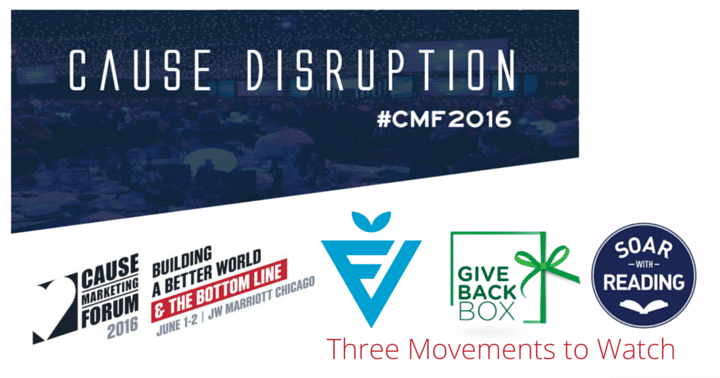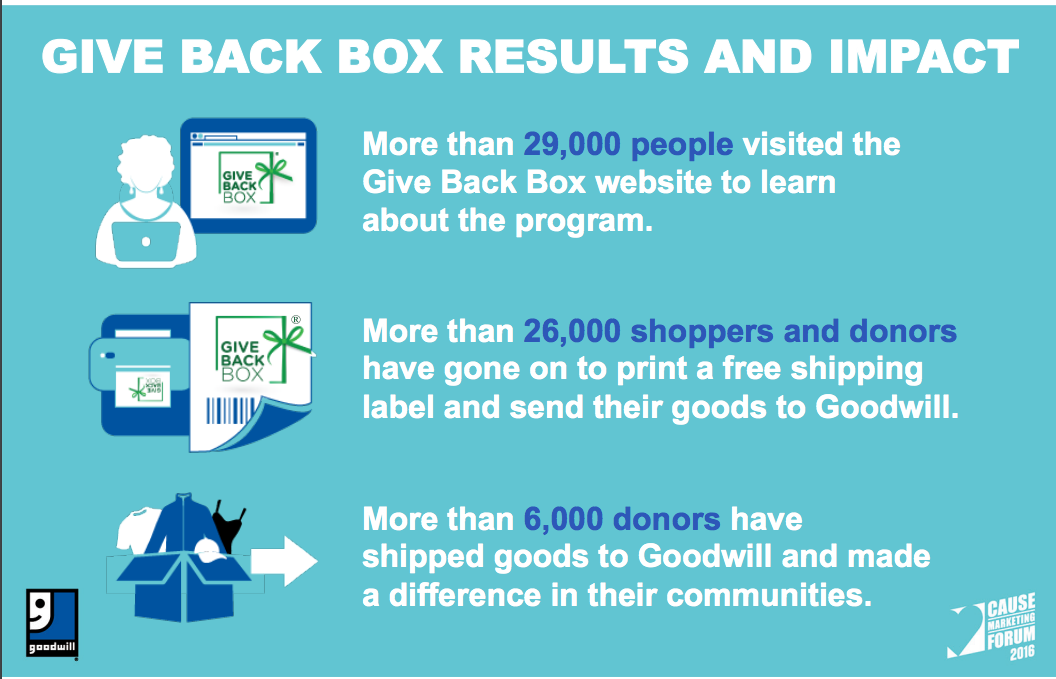
By: Mollye Rhea, President and Founder, For Momentum
Back from Chicago, I’ve had a little time to reflect on the sessions and ideas that most hit home for me at last week’s Cause Marketing Forum Conference. One of the themes of this year’s conference was cause disruption. The conference showcased the causes and brands that are steering away from the status quo and creating innovative campaigns that capitalize on a rapidly changing marketplace. While there are many worthy candidates, I’ve identified three of the movements we should all be watching based on the amazing results these organizations are already realizing and the potential impact they have on our future.
Partnership for a Healthier America’s Fruits and Veggies (FNV) Campaign
Given that kids view 5,500 television commercials for junk food vs. 100 ads for healthy food each year, it’s no wonder that our country struggles with a childhood obesity epidemic. Since research also shows that children are more likely to eat or drink something endorsed by an athlete or a celebrity, the Partnership for a Healthier America saw an opportunity to reverse the trend of promoting unhealthy eating. Launched last year, the Fruits and Veggies (FNV) campaign recruited more than 70 celebrities and athletes to appear in a series of advertisements promoting eating produce. These were not paid endorsements by the way; all the celebrities volunteered their time and likenesses to Team FNV.
During her presentation at the Cause Marketing Forum Conference, Ryan Shadrick Wilson, Chief Strategy Officer and General Counsel at Partnership for a Healthier America, said the FNV campaign has already garnered more than a billion impressions and almost 40,000 social media mentions. In a national study of those who said they recognized FNV, about 70 percent said they bought and ate more fruits and veggies after seeing or hearing the campaign. FNV retail partners report an increase in sales of produce. Partnership for a Healthier America hopes to strengthen FNV into a major consumer brand this year, picking from a bushel of celebrity endorsements and corporate partnerships and planting seeds for a healthier generation of kids.
Goodwill’s Give Back Box Campaign
Michael Meyer, Vice President, Donated Goods Retail and Marketing at Goodwill Industries International, explained the thought process behind the Give Back Box program in a unique and powerful way at the conference. Instead of jumping right into the details of the campaign, Meyer focused on brands that had become extinct because they had not anticipated or adapted to marketplace change. One prime example that he gave was Blockbuster, a company that had an opportunity to change its business model from brick and mortar stores charging late fees on movie rentals to an at-home subscription model offered by Netflix. Meyer said Blockbuster failed to innovate and act sooner, and that inaction resulted in Blockbuster going out of business in 2013.
 What does this have to do with Goodwill and the Give Back Box? Meyer said that while Goodwill still receives most of its funding through in-person donations at local Goodwill stores, the organization recognizes that more people are shopping online. Therefore, they launched the Give Back Box platform, which enables online customers to donate clothes and other lightly used items to their local Goodwill stores using the boxes from their favorite online retailers, like Levi’s and Overstock.com. The movement has already experienced success, with more than 6,000 donors already shipping items in Give Back Boxes to their local Goodwills. Over time, the program has the potential to not only help fund Goodwill’s mission of training and finding jobs for thousands of Goodwill participants, but reduce the amount of cardboard and other textiles waste in our landfills. That’s out-of-the-box thinking that keeps on giving!
What does this have to do with Goodwill and the Give Back Box? Meyer said that while Goodwill still receives most of its funding through in-person donations at local Goodwill stores, the organization recognizes that more people are shopping online. Therefore, they launched the Give Back Box platform, which enables online customers to donate clothes and other lightly used items to their local Goodwill stores using the boxes from their favorite online retailers, like Levi’s and Overstock.com. The movement has already experienced success, with more than 6,000 donors already shipping items in Give Back Boxes to their local Goodwills. Over time, the program has the potential to not only help fund Goodwill’s mission of training and finding jobs for thousands of Goodwill participants, but reduce the amount of cardboard and other textiles waste in our landfills. That’s out-of-the-box thinking that keeps on giving!
JetBlue’s Soar with Reading Program
A winner of this year’s Golden Halo Award for Business, JetBlue has landed on a winning cause for its customers and the communities it serves. In 2011, the airline launched Soar with Reading, a program designed to promote literacy and put books in the hands of kids in underserved “book deserts.” In his presentation, Mike Elliott, Chief People Officer at JetBlue, said that the ratio of books to children in middle class neighborhoods is 13-to-1. In low-income communities, the ratio of books to children is 1-to-300.
In 2014, the Soar with Reading program really took off when JetBlue started placing vending machines in neighborhoods where the books were most needed. Not only are the books in the vending machines free, but the kids get to take the books home with them and start their own little libraries. In the last five years, JetBlue and its partners have donated over $1.7 million worth of children’s books. By providing access to these free books, JetBlue is giving flight to kids’ imaginations and educations.
In addition to these three new campaigns, I’d like to recognize one special campaign that has been around for decades and was this year’s Golden Halo Award Winner for Cause—Safe Kids Worldwide. Safe Kids has had a staggering impact. In her keynote address, Kate Carr, President and CEO of Safe Kids Worldwide, reported that the number of unintentional deaths of kids under the age of 19 has gone from almost 17,000 in 1987 to 7,593 in 2014. That’s more than a 50 percent decrease in the number of accidental deaths. All of these movements demonstrate tremendous passion, impact and infinite possibilities for the future. Thank you Cause Marketing Forum for the fabulous, thought-provoking agenda, and kudos to all these campaigns for “Building a Better World and the Bottom Line!”

Leave a Reply